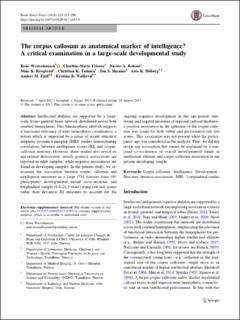| dc.contributor.author | Westerhausen, Rene | |
| dc.contributor.author | Friesen, Charline-Marie | |
| dc.contributor.author | Rohani, Darius | |
| dc.contributor.author | Krogsrud, Stine Kleppe | |
| dc.contributor.author | Tamnes, Christian Krog | |
| dc.contributor.author | Skranes, Jon Sverre | |
| dc.contributor.author | Håberg, Asta | |
| dc.contributor.author | Fjell, Anders Martin | |
| dc.contributor.author | Walhovd, Kristine B | |
| dc.date.accessioned | 2021-04-28T07:56:29Z | |
| dc.date.available | 2021-04-28T07:56:29Z | |
| dc.date.created | 2017-10-24T14:00:55Z | |
| dc.date.issued | 2017 | |
| dc.identifier.citation | Brain Structure and Function. 2017, 223 285-296. | en_US |
| dc.identifier.issn | 1863-2653 | |
| dc.identifier.uri | https://hdl.handle.net/11250/2740056 | |
| dc.description.abstract | Intellectual abilities are supported by a large-scale fronto-parietal brain network distributed across both cerebral hemispheres. This bihemispheric network suggests a functional relevance of inter-hemispheric coordination, a notion which is supported by a series of recent structural magnetic resonance imaging (MRI) studies demonstrating correlations between intelligence scores (IQ) and corpus-callosum anatomy. However, these studies also reveal an age-related dissociation: mostly positive associations are reported in adult samples, while negative associations are found in developing samples. In the present study, we re-examine the association between corpus callosum and intelligence measures in a large (734 datasets from 495 participants) developmental mixed cross-sectional and longitudinal sample (6.4–21.9 years) using raw test scores rather than deviation IQ measures to account for the ongoing cognitive development in this age period. Analyzing mid-sagittal measures of regional callosal thickness, a positive association in the splenium of the corpus callosum was found for both verbal and performance raw test scores. This association was not present when the participants’ age was considered in the analysis. Thus, we did not reveal any association that cannot be explained by a temporal co-occurrence of overall developmental trends in intellectual abilities and corpus callosum maturation in the present developing sample. | en_US |
| dc.language.iso | eng | en_US |
| dc.publisher | Springer | en_US |
| dc.rights | Navngivelse 4.0 Internasjonal | * |
| dc.rights.uri | http://creativecommons.org/licenses/by/4.0/deed.no | * |
| dc.title | The corpus callosum as anatomical marker of intelligence? A critical examination in a large-scale developmental study | en_US |
| dc.type | Peer reviewed | en_US |
| dc.type | Journal article | en_US |
| dc.description.version | publishedVersion | en_US |
| dc.source.pagenumber | 285-296 | en_US |
| dc.source.volume | 223 | en_US |
| dc.source.journal | Brain Structure and Function | en_US |
| dc.identifier.doi | 10.1007/s00429-017-1493-0 | |
| dc.identifier.cristin | 1507282 | |
| dc.relation.project | Notur/NorStore: NS9084S | en_US |
| cristin.ispublished | true | |
| cristin.fulltext | original | |
| cristin.qualitycode | 2 | |

